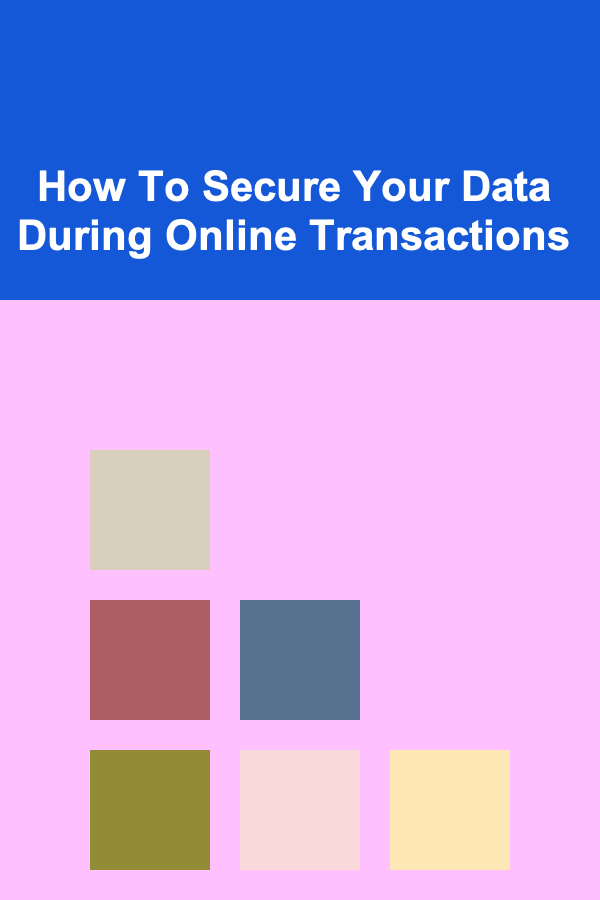
How To Secure Your Data During Online Transactions
ebook include PDF & Audio bundle (Micro Guide)
$12.99$6.99
Limited Time Offer! Order within the next:

In today's digital age, online transactions have become a fundamental part of our daily lives. Whether you are shopping online, transferring money, or paying for a subscription, the convenience of online transactions cannot be overstated. However, with this convenience comes a significant risk -- the potential exposure of sensitive personal data. Online transactions can be vulnerable to cyberattacks, fraud, and data breaches. This article will explore how you can secure your data during online transactions, ensuring your information remains safe from malicious actors.
The Importance of Securing Data in Online Transactions
Data breaches and cybercrimes are on the rise. In 2020 alone, it was reported that over 36 billion records were exposed due to data breaches worldwide. Financial institutions, e-commerce websites, and even social media platforms have fallen victim to security compromises, with hackers gaining access to payment details, personal addresses, and even social security numbers. As a result, securing data during online transactions is not just a matter of convenience but a critical necessity to protect your identity, finances, and personal privacy.
Online transactions involve the exchange of sensitive information, including credit card numbers, bank account details, and personal identifiers. If this data falls into the wrong hands, it can lead to identity theft, financial losses, and even reputational damage. Therefore, adopting best practices for securing your data during online transactions is essential.
The Threats to Online Transactions
Before we delve into how to protect your data, it's essential to understand the various threats that exist in the digital world.
1. Phishing Attacks
Phishing is one of the most common methods cybercriminals use to steal sensitive information. In a phishing attack, a hacker impersonates a trusted entity, such as a bank or an online retailer, to trick individuals into providing their login credentials, credit card information, or other personal details. Phishing can occur through emails, text messages, or fake websites that appear legitimate but are designed to capture your data.
2. Malware and Ransomware
Malware is a form of software that is designed to infiltrate your computer or mobile device to steal data or cause harm. Ransomware, a type of malware, locks your data and demands payment for its release. Malware can be introduced into your system through malicious email attachments, compromised websites, or apps that you download.
3. Man-in-the-Middle (MITM) Attacks
A man-in-the-middle attack occurs when a hacker intercepts the communication between two parties, such as between you and a website you are purchasing from. The hacker can steal sensitive data, such as login credentials and payment details, without either party being aware of the interception.
4. Weak Passwords
Weak passwords are an easy target for cybercriminals. If you use simple, easy-to-guess passwords like "123456" or "password," it only takes a few seconds for a hacker to gain access to your accounts. Weak passwords are especially problematic for online transactions, as they can lead to unauthorized purchases or identity theft.
5. Data Breaches
Even if you take every precaution on your end, your data may still be vulnerable if the businesses you transact with suffer a data breach. Large-scale breaches can expose millions of users' information, including their payment details, home addresses, and other personally identifiable information.
How to Secure Your Data During Online Transactions
Now that we've covered the various threats, let's explore practical steps you can take to secure your data during online transactions.
1. Use Secure Websites (HTTPS)
One of the easiest ways to ensure your data is protected is to check for secure websites when making transactions. Always look for the "HTTPS" prefix in the website's URL. The "S" stands for secure, and it indicates that the website uses encryption to protect your data. HTTPS ensures that any data exchanged between your browser and the website is encrypted, making it harder for hackers to intercept or manipulate the information.
Never enter personal or financial information on a website that does not use HTTPS, especially when making payments.
2. Enable Two-Factor Authentication (2FA)
Two-factor authentication (2FA) is a security feature that adds an extra layer of protection to your online accounts. Instead of relying solely on a password, 2FA requires you to provide two pieces of information: something you know (your password) and something you have (like a phone or security key). Even if a hacker gains access to your password, they would still need the second form of authentication to access your account.
Many banks, online retailers, and other services offer 2FA as an option, and it is highly recommended to enable it for all your financial and sensitive accounts.
3. Use Strong, Unique Passwords
Using strong, unique passwords is one of the simplest yet most effective ways to secure your online accounts. Avoid using easily guessable passwords, such as "password123" or "qwerty." Instead, use a combination of upper and lowercase letters, numbers, and special characters to create a robust password. Aim for passwords that are at least 12 characters long.
Consider using a password manager to help you generate and store strong passwords. Password managers can also help you avoid reusing passwords across multiple sites, which is another common vulnerability.
4. Monitor Your Bank and Credit Card Statements
Regularly monitoring your bank and credit card statements is a crucial step in catching any fraudulent transactions early. Many banks and financial institutions offer alert systems that notify you of any suspicious activity, such as large transactions or purchases from unfamiliar locations. Setting up these alerts can help you quickly spot unauthorized transactions and take action before significant damage occurs.
5. Avoid Public Wi-Fi for Financial Transactions
Public Wi-Fi networks, such as those found in coffee shops, airports, or hotels, are not secure and can be exploited by hackers to intercept data. Avoid making online transactions or accessing sensitive accounts while connected to public Wi-Fi. If you must use a public network, consider using a Virtual Private Network (VPN) to encrypt your internet connection and protect your data.
6. Be Cautious with Email and Text Messages
Be wary of unsolicited emails and text messages, especially those that ask you to click on links or download attachments. These could be phishing attempts designed to steal your information. Always verify the sender before clicking any links, and if you receive an email from a business or financial institution, go directly to their website to log in rather than using any links provided in the message.
7. Use Trusted Payment Methods
When making purchases online, consider using trusted payment methods such as credit cards, PayPal, or other secure digital wallets. These payment methods offer an additional layer of protection, as they may offer fraud protection services that help resolve disputes if unauthorized charges occur.
Credit cards are particularly beneficial because they often come with fraud protection, meaning you can dispute charges if something goes wrong. Avoid using debit cards for online transactions, as they may not offer the same level of protection.
8. Keep Your Devices and Software Updated
Regularly updating your operating system, apps, and antivirus software is crucial for protecting your devices from the latest security vulnerabilities. Cybercriminals often exploit unpatched security flaws in outdated software to gain unauthorized access to your information.
Make sure your devices are set to automatically update, or periodically check for updates manually. This will help ensure that you have the latest security patches and bug fixes.
9. Avoid Storing Payment Information on Websites
While many e-commerce websites offer the option to save your payment information for convenience, this can put your data at risk. If the website is ever compromised, your saved payment details could be stolen.
Consider avoiding this feature and entering your payment information each time you make a purchase. If you must store payment information, ensure that the website is reputable and uses strong security measures.
10. Use a Virtual Credit Card
Some financial institutions and payment services offer virtual credit cards for online transactions. These are temporary, disposable cards that can be used for one-time purchases or subscriptions. Virtual cards can help protect your real credit card number from being exposed in case of a breach.
11. Educate Yourself About Security Threats
Finally, one of the most effective ways to protect your data is to stay informed about the latest cybersecurity threats. Cybercriminals are constantly coming up with new tactics to exploit vulnerabilities, and being aware of these threats can help you avoid falling victim to them.
Regularly read articles, blogs, or watch videos about online security best practices to stay updated on the latest developments. Many organizations also offer free cybersecurity courses to help you better understand how to protect your data.
Conclusion
Securing your data during online transactions is essential for protecting your privacy, identity, and financial information. By understanding the risks and following best practices, such as using secure websites, enabling two-factor authentication, using strong passwords, and being cautious with public Wi-Fi, you can significantly reduce the chances of falling victim to cyberattacks and fraud.
Remember, your data is valuable, and taking the necessary precautions to secure it during online transactions will help safeguard it from malicious actors. Stay informed, be proactive, and always prioritize security when engaging in online activities.

How to Create a Home Storage System for Digital Clutter
Read More
How to Generate Passive Income by Developing AI SaaS Solutions
Read More
How to Incorporate Task Lighting in Your Kitchen
Read More
How to Make Family Time Meaningful with Daily Rituals and Routines
Read More
How to Make Money Online as an App Reviewer: 10 Actionable Ideas
Read More
How to Use Deep Learning to Generate Passive Income in Multiple Ways
Read MoreOther Products

How to Create a Home Storage System for Digital Clutter
Read More
How to Generate Passive Income by Developing AI SaaS Solutions
Read More
How to Incorporate Task Lighting in Your Kitchen
Read More
How to Make Family Time Meaningful with Daily Rituals and Routines
Read More
How to Make Money Online as an App Reviewer: 10 Actionable Ideas
Read More